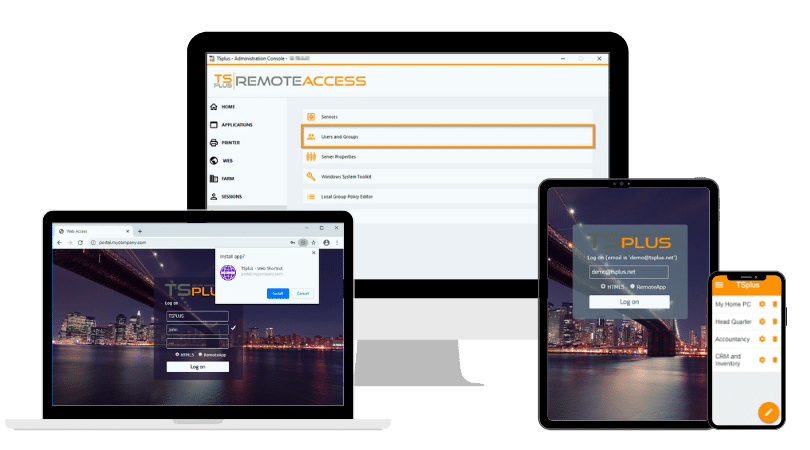)
)
Remote Desktop is an essential tool for remote work, IT support and personal convenience. It allows you to access your computer from another location as if you were sitting right in front of it. However, improper setup can lead to serious security risks, including unauthorized access or data breaches. In this guide, learn how to securely and efficiently configure Remote Desktop on Windows systems, alongside an easier, safer option: TSplus Remote Access .
What is Remote Desktop & How Does It Work?
Remote Desktop is a built-in Windows feature that allows you to connect to and control a computer remotely over a network connection. It mirrors the experience of sitting in front of the computer, giving you full access to your desktop, files and applications, regardless of your physical location.
Access From Anywhere Via a Network Connection:
One of its biggest strengths is flexibility: it works on different devices like Windows PCs, Macs, smartphones and tablets. You can either connect through dedicated Microsoft software, ensuring a consistent experience across platforms, or third-party options, where this may take more configuration.
To better understand how Remote Desktop fits into the broader context of remote access tools and Windows Server environments, visit Microsoft’s Remote Desktop Overview .
Configuration Needs and Security:
However, Remote Desktop requires proper configuration to work securely and efficiently. It is essential to understand how it fits within your network before enabling it, especially in corporate environments.
Widely Used for Various Purposes:
- Remote Work: Access your office computer from home or while travelling.
- IT Support: Help others troubleshoot technical issues remotely.
- Access to Resources: Retrieve files and use applications installed on another PC.
Examples of how it can be applied:
Remote Desktop is especially useful for businesses that need centralised management of systems or applications. Employees can work from home and without needing to transport devices physically, reducing hardware costs as well as simplifying workflows.
What Are the Requirements?
Before setting up Remote Desktop, it is crucial to ensure that your system meets several important requirements. Skipping these verifications can later lead to setup errors or failed connections.
Here are items you should check:
- Windows Edition
- Network Configuration
- User Permissions
- Stable Internet Connection
- Firewall Settings
Windows Edition
Remote Desktop is available only on specific Windows editions, such as Pro, Enterprise or Education. If you are using Windows Home, you will not be able to use this feature for incoming connections unless you upgrade to a supported version.
To check your edition:
- Go to Settings > System > About
- Scroll to Windows specifications to see your edition.
Network Configuration
Ensure your device is connected to the correct network, either via Ethernet or Wi-Fi. You may need to adjust your router or firewall settings to allow Remote Desktop connections through. TCP port 3389 .
User Permissions
You must have administrator privileges to enable Remote Desktop. Only authorised users can activate or configure it. You can also add specific user accounts that are permitted to connect.
Stable Internet Connection
For remote connections over the internet, ensure both devices have a strong, stable internet connection. This helps maintain performance and avoid disconnections.
Firewall Settings
You may need to allow Remote Desktop through Windows Firewall. Windows usually offers to do this automatically during the setup process, but manual configuration may be required in some cases.
By ensuring these prerequisites are met, you can prevent common setup issues and make your Remote Desktop experience smoother and more secure.
How Can You Set Up Remote Desktop (Windows)?
This section will cover how to set up Remote Desktop on the following setups:
- Windows 11
- Windows 10
- Windows 7 & Early Windows 10 Setup
Windows 11 Setup
- Click Start and open Settings.
- Select System and then Remote Desktop.
- Toggle the Remote Desktop switch to On and confirm.
- Note your PC name listed under Remote Desktop settings. You will need it later to connect.
Windows 10 Setup
- Go to Start and click Settings.
- Select System > Remote Desktop.
- Enable Remote Desktop by toggling the switch to On.
- Under User Accounts, click Select users to add those permitted to connect.
- Note your PC name for future connection.
Windows 7 & Early Windows 10 Setup
- Open the Control Panel.
- Navigate to System and Security > System > Remote Settings.
- In the Remote tab, enable Allow Remote Connections to This Computer.
- Decide whether to enable Network Level Authentication (NLA) for added security.
- Add users who are authorised to connect.
- Apply the settings and note your PC name.
How Can You Connect Using Remote Desktop?
Once Remote Desktop is properly configured, connecting to your device remotely is simple. This allows you to work from almost anywhere with ease. Here is how to connect using different types of devices.
Windows Devices
- Open the Remote Desktop Connection app from the Start Menu or by typing it in the search bar.
- Enter the PC name or IP address of the device you wish to connect to, as noted during setup.
- Click Connect and enter the credentials of an authorised user account when prompted.
Mac, iOS & Android Devices
- Install the official Microsoft Remote Desktop App from your device’s app store Mac App Store, Google Play, Microsoft Store.
- Open the app and select Add PC.
- Enter the same PC name or IP address used during setup.
- Tap Connect and log in with your user credentials.
Remote Desktop also supports customizable settings, allowing you to adjust display resolutions, audio and peripheral options for a better remote experience. For mobile users, touch controls are available for easy navigation.
What are the Essential Security Tips for Remote Desktop?
Using Remote Desktop can be highly convenient, but security must be a top priority to prevent unauthorized access. Following these best practices will help you use Remote Desktop safely:
- Enable Strong Passwords
- Activate Network Level Authentication
- Restrict Access by IP Address
- Use a Virtual Private Network (VPN)
- Keep Your Devices Updated
- Avoid Open Internet Exposure
Enable Strong Passwords
Require complex, unique passwords for every user account allowed to connect via Remote Desktop. Passwords should include uppercase and lowercase letters, numbers, and symbols.
Activate Network Level Authentication (NLA)
NLA ensures that users must authenticate before a remote session starts, preventing unauthorized access and reducing security risks.
Restrict Access by IP Address
Use your firewall or router settings to limit Remote Desktop access to known IP addresses or specific networks only.
Use a Virtual Private Network (VPN)
Whenever possible, route Remote Desktop connections through a VPN for an added layer of encryption and security.
Keep Your Devices Updated
Ensure your operating system and Remote Desktop apps are always updated with the latest security patches.
How Can You Avoid Open Internet Exposure?
Never leave Remote Desktop accessible directly from the internet without such protections as NLA or a VPN. To understand how properly securing firewalls and remote access tools is essential to protect your network against ransomware and unauthorized access, the CISA’s Security Guide for Remote Work can help.
Additionally, consider enabling account lockout policies to block repeated failed login attempts, which helps prevent brute-force attacks. Combining these steps creates a safer remote working environment.
TSplus Remote Access: A Secure & Affordable Alternative
While native RDP works for many users, it requires careful configuration and constant monitoring. TSplus Remote Access offers an easier, safer solution for remote desktop needs.
Key Benefits:
Simplified Setup:
No need to adjust complex firewall rules or manage multiple user settings manually.
Strong Security:
TSplus automatically encrypts connections with SSL and can include a seamless Two-Factor Authentication (2FA) add-on, as well as robust security software .
Cost-Effective:
Unlike expensive remote solutions, TSplus provides affordable licensing, with a choice of perpetual or subscription.
Versatile Features:
TSplus enables full desktop access or specific application publishing. It supports multiple users and offers load balancing and reverse proxy features for scalability.
Simplicity, Efficiency, Security:
Consequently, you gain a simple framework built to keep your data, applications and servers secure and your setup affordable. TSplus also supports a number of essential features enabling granular control and scalability. What’s more, its quick setup process allows you to download, install and start secure remote sessions within minutes.
Conclusion
Setting up Remote Desktop lets you work from anywhere but often requires careful preparation to avoid security risks. Indeed, native RDP provides essential functionality but lacks robust protection on its own.
As a simpler, scalable, more secure alternative, TSplus Remote Access is a standout choice. With easy setup, SSL encryption and versatile application delivery, TSplus makes Remote Desktop set up smoother and remote work both safer and more efficient.

TSplus Remote Access Free Trial
Ultimate Citrix/RDS alternative for desktop/app access. Secure, cost-effective, on-premises/cloud














)
)
)